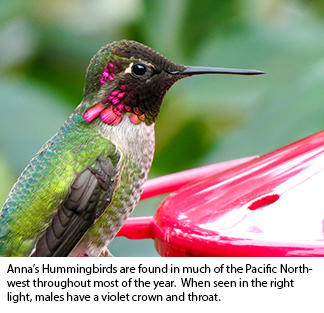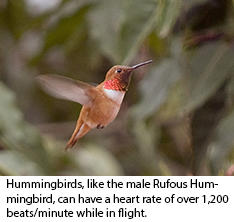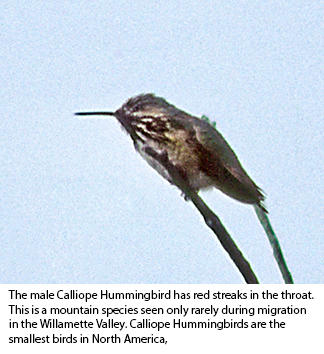Hummingbirds
Hummingbirds may be among the smallest of warm-blooded creatures, but don't equate size with fragility. Many hummingbirds live 10 to 12 years and can survive quite harsh conditions. Hummingbirds even live above 8,000 feet in the Andes. One of North America’s hardiest hummingbirds may be the Pacific Northwest’s Anna's hummingbird found here year-round. Even in harsh winter conditions these hummingbirds will still visit your feeders.

Many of us are concerned about hummingbirds' well-being when temperatures fall below freezing, but they are amazingly resilient and do well even in cold environments. What helps them most is to keep your feeders filled with fresh sugar-water and either find a heat source to keep it from freezing or swap unfrozen feeders as frequently as necessary. Here at Eugene Wild Birds Unlimited, and at some other WBI stores in the Pacific Northwest, we sell a hummingbird feeder heater designed to fit below our hummingbird feeders that will keep the sugar solution from freezing.
People may be initially surprised to see hummingbirds in mid-winter, but the Anna's Hummingbird is present throughout the year.. Because they live here year-round, it’s a good idea to keep a hummingbird feeder filled with fresh nectar all year. Though often-repeated, one erroneous belief holds that keeping your feeder up prevents hummingbirds from migrating. But there is absolutely no truth to this. First, Anna's Hummingbirds never leave the area, and when it is time to migrate for other species, nothing, short of physical restraint, will prevent a migrating bird from leaving. The instinct to do so is simply too strong.
Hummingbirds have very high metabolisms and require frequent food. To survive night temperatures, hummingbirds must reduce their fuel needs and to do so, they go into a condition called torpor, greatly slowing their metabolic rate. Body temperatures fall from 102°F to about 45°F and heart rates drop from 400 beats/minute to near 40 beats/minute, thus reducing fuel requirements by about 65%. Hummingbirds in torpor may look and seem to be dead, clinging tightly with their feet locked around a small branch, eyes closed, and beak often pointing skyward. They will feel cold, lifeless and are unresponsive to touch. Then, shortly before dawn they begin to waken by shivering to warm the muscles, complete revival usually taking about an hour. People have found hummingbirds in torpor and thinking that they were dead, occasionally have put "dead" hummingbirds in a trash bin only to hear them fluttering around inside trying to escape an hour or so later. If you find a hummingbird in this condition it is best to leave it alone; it may simply be in torpor and will have a normal recovery to daytime activities.

To make hummingbird nectar for your feeder use only 1 part sugar and 4 parts water. Use only pure white table sugar as this most closely mimics nectar produced by hummingbird flowers. White table sugar is pure sucrose and natural flower nectar is exactly the same thing, so using it is providing the hummingbird what it most needs. Avoid using “organic” sugars as most are not as fully processed, and the slightly brownish color is molasses, which hummingbirds cannot digest. Never use honey because it's a combination of sugars, most which hummingbirds cannot digest or not digest easily, plus it often contains fungal spores that can infect hummingbird tongues, making it impossible for affected birds to feed. If you have ever seen a hummingbird with it tongue sticking out and unable to retract it, the bird may have been feeding at a feeder where someone used honey and fungal spores have germinated on the tongue and/or gullet. Unable to retract the tongue, the bird cannot feed and will soon die.
You may see the suggestion to increase the concentration of sugar during winter from 1:4 to 1:3, or worse, to 1:2. Please do NOT increase the concentration beyond 1:4. Most hummingbird flowers actually have nectar with a sugar concentration of 1:5 so the traditional mix of 1:4 is actually more concentrated than flowers. Increasing it beyond that risks causing dehydration in the tissues of the hummingbird. Although some people think the higher concentration works “better” because hummingbirds visit more frequently, in truth they do so because they are thirsty. The more they drink of high sugar nectar, the thirstier and more dangerously dehydrated they become, so please stay with the expert’s recommended 1:4 solution. Rufous Hummingbirds are able to tolerate a 1:3 sugar concentration more easily, but I still recommend staying with a 1:4 ratio. The flowers most attractive to Rufous Hummingbirds have a nectar sugar that is typically 1:4. Flowers most attractive to Anna’s Hummingbirds have a nectar ratio that is 1:5 or 1:6 in sugar concentration.

Never add color of any kind and avoid pre-mixed red commercial nectars. Color is completely unnecessary as the birds find the solution well without color. Some manufacturers of commercial hummingbird food argue that there are no studies showing any harm to the birds. Technically, they are correct, there are no direct studies involving hummingbirds. But, there are numerous studies of food dyes and their effects on humans, lab animals and cells in tissue culture. There are some good Japanese studies using mice that are similar in size and physiology to hummingbirds that show a direct correlation between red dye and intestinal tumors. We know the results would be similar in hummingbird so why put them at risk just to prove a point.
A hummingbird needs to drink 2.5 times its weight in sugar water each day and more in cold temperatures. Studies on Red Dye No. 40, a dye often used, show that its effects are dose-dependent and a small hummingbird can get up to ten times more than the daily dosage that a Japanese study found damaged DNA and caused tumors in mice colons. So please don't put hummingbirds at risk by adding or using any dyed preparations. We also caution against using proteins, vitamins, etc. Even is cold weather, hummingbirds get these in other foods (small insects, spiders and their eggs). Don't overload these tiny beautiful bodies with excess supplements.
Like other animals, hummingbirds do need protein in their diet. They get plenty of protein by eating insects and spiders. These are available throughout the year. You may not see many insects in winter, but plenty can be found on the surfaces of plants as well as small spiders and their egg masses. A hummingbird can only exist on sugar-water for 8-10 days so these arthropods are very important in the hummingbird’s diet and they easily fin them throughout the year. These animals also become important to hummingbirds during the time of raising young. For proper health and growth, the youngsters need daily protein. You may have noticed a decrease in hummingbird activity at you feeder during the breeding season and this is partially because of the greater dependence on insects. Additionally, more wild flowers are available for the birds to visit.
Hummingbirds can fill us with wonder and surprise us when they visit our yards. It only takes a little extra effort on your part to give them some additional help when our weather turns cold for extended periods.

